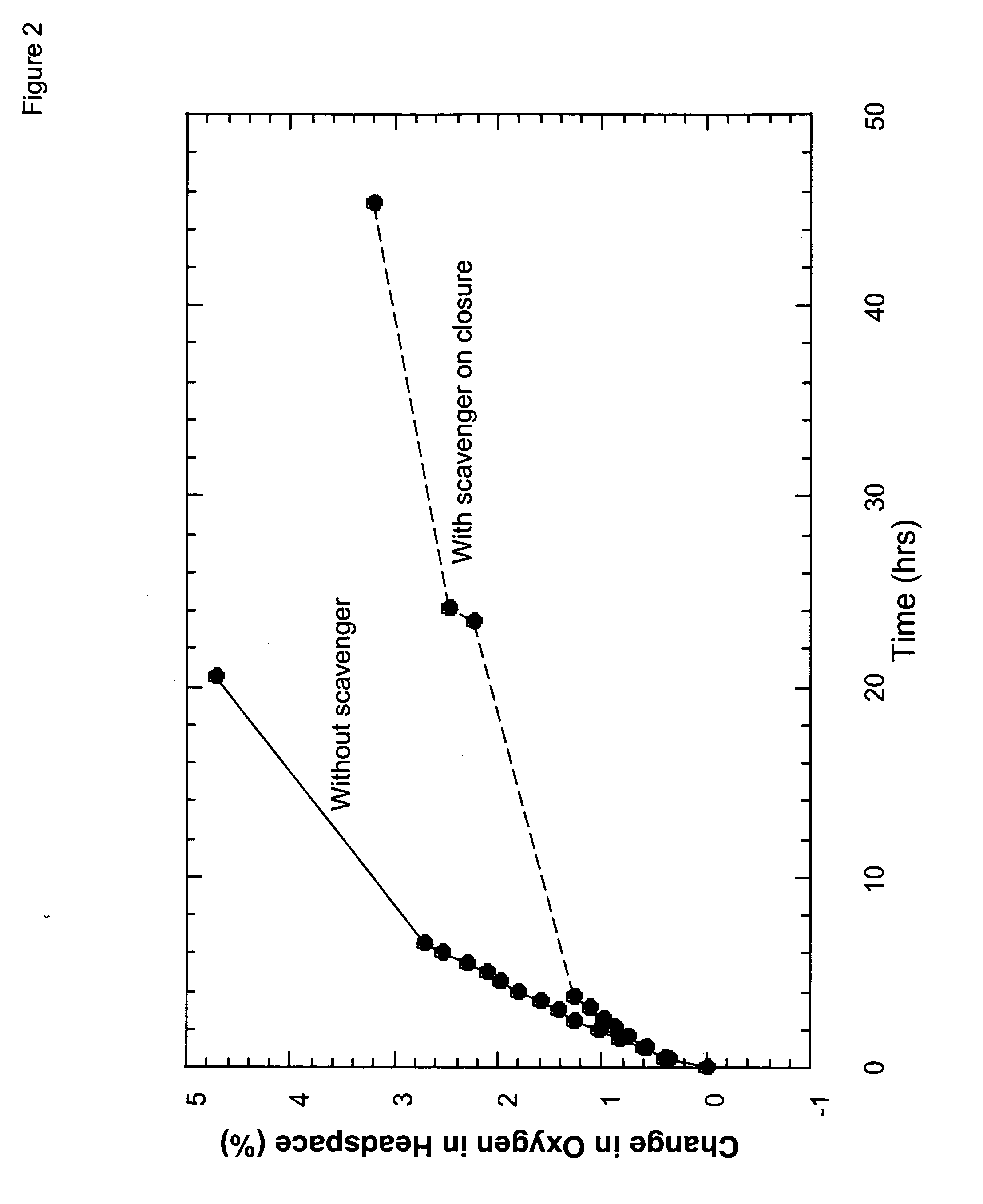Oxygen scavenging compositions and methods of use
a technology of compositions and oxygen, applied in the field of oxygen scavenging systems, can solve the problems of difficult to achieve the complete removal of osub>2 /sub>, difficult to achieve the effect of osub>2 /sub>, and difficult to achieve the effect of complete removal,
- Summary
- Abstract
- Description
- Claims
- Application Information
AI Technical Summary
Benefits of technology
Problems solved by technology
Method used
Image
Examples
example 1
A Liquid O2 Scavenging Composition
[0140] The present Example describes use of an O2 scavenging system to effectively scavenge headspace O2 in a sealed container, herein the system was composed of an O2 scavenging composition (i.e., laccase and sodium ascorbate) dissolved in water.
[0141] Specifically, an O2 scavenging composition consisting of 640 mg of sodium ascorbate and 0.4 mg of T. versicolor laccase (Wacker Chemie) in 1.5 mL of water was placed into an air-filled bottle fitted with a Qubit Systems (Kingston, Ontario) gas-phase O2 sensor. The O2 concentration at room temperature was measured over time. It dropped from an initial value of 20.9% to 3.5% after 58 hr.
example 2
Comparison of Activity of Various Laccases on Paper Strips
[0142] The present Example compares O2 scavenging achieved using a liquid O2 scavenging composition (i.e., laccase and sodium ascorbate) applied to a paper surface, wherein the activity of laccases from different sources are tested for their applicability.
[0143] The protein concentration of laccase from four different sources was determined using the Bio-Rad protein assay (Bio-Rad, Hercules, Calif.), and adjusted to a concentration of 1.25 mg / mL. A solution consisting of 650 μl sodium ascorbate (500 mg / mL in 10 mM MES) and 100 μl of enzyme was made up for each enzyme, and applied to 2.54×7.6 cm strips of Whatman 3MM filter paper (Kent, UK). Each strip was placed in a separate 125 mL jar fitted with a Qubit Systems (Kingston, Ontario) gas phase O2 sensor.
[0144] The O2 concentration at room temperature was measured over 72 hrs. The identity of the laccases and the final O2 concentrations are shown in the Table below.
TABLE ...
example 3
Comparison of Activity of Various Non-Ascorbate Reductants on Paper Strips
[0145] The present Example compares O2 scavenging achieved using a liquid O2 scavenging composition (i.e., laccase and reductant) applied to a paper surface, wherein the activity of different non-ascorbate reductants are tested for their applicability.
[0146] Specifically, the reductant activity of a variety of Generally Recognized as Safe (GRAS) reductants were tested below, by mixing laccase and the candidate reductant in a sealed container and measuring the loss of O2; however, since the GRAS reductants were not water-soluble, it was necessary to first dissolve each in canola oil and then prepare emulsions (using lecithin as a surfactant). Each emulsion thus contained the following components: 200-250 mg of candidate reductant, 500 μl of canola oil, 100 μl lecithin (saturated solution in ethanol), and 100 μl Myceliophthora thermophilia laccase (Novozymes, 0.2-9.5 mg in water). The components were vortexed ...
PUM
| Property | Measurement | Unit |
|---|---|---|
| volume | aaaaa | aaaaa |
| concentration | aaaaa | aaaaa |
| concentration | aaaaa | aaaaa |
Abstract
Description
Claims
Application Information
 Login to View More
Login to View More - R&D
- Intellectual Property
- Life Sciences
- Materials
- Tech Scout
- Unparalleled Data Quality
- Higher Quality Content
- 60% Fewer Hallucinations
Browse by: Latest US Patents, China's latest patents, Technical Efficacy Thesaurus, Application Domain, Technology Topic, Popular Technical Reports.
© 2025 PatSnap. All rights reserved.Legal|Privacy policy|Modern Slavery Act Transparency Statement|Sitemap|About US| Contact US: help@patsnap.com


